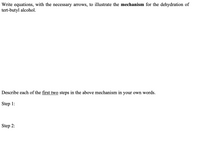
Chemistry
10th Edition
ISBN: 9781305957404
Author: Steven S. Zumdahl, Susan A. Zumdahl, Donald J. DeCoste
Publisher: Cengage Learning
expand_more
expand_more
format_list_bulleted
Question

Transcribed Image Text:Write equations, with the necessary arrows, to illustrate the mechanism for the dehydration of
tert-butyl alcohol.
Describe each of the first two steps in the above mechanism in your own words.
Step 1:
Step 2:
Expert Solution
This question has been solved!
Explore an expertly crafted, step-by-step solution for a thorough understanding of key concepts.
Step by stepSolved in 2 steps with 1 images

Knowledge Booster
Similar questions
- 1.Draw a structural formula for the more stable carbocation intermediate formed in the reaction shown. 2.Draw a structural formula for the major organic product of the reaction shown.arrow_forward6) The substitution reaction below to produce 1-iodobutane was performed using 1-bromobutane at a 0.1 M concentration and sodium iodide at a 0.1 M concentration. What would the rate law be for the reaction below? How would you expect the rate of the reaction to change if a 0.2 M concentration of sodium iodide was used? How would you expect the rate constant to change? Explain. Nal (0.1 M) Br acetone (0.1 M)arrow_forwardFurfuryl ethyl ether (FEE) was identified as a component that forms in aged beer, giving it a solvent-like taste U. Agric. Food Chem, 2004, 52, 1661) This ether can be formed from furfuryl alcohol (FALC, by either S,1 or S2 mechanisms. CH,CH,OH OCH,CH, furtury alcohol (prolonatec) furfuryl ethyl ether FEE) Draw a reasonable mechanism of the SN1 formation of FEE. Explain why it is possible for FALC to underga a SNI reaction, even though it would have to form a primary carbocationarrow_forward
- How many covalent bonds are predicted for an atom of N? Enter your answer in the provided box.arrow_forwardAnalyze the following reaction mechanisms. How many bond forming events occur in this mechanism? OH tot t + H₂O Acetone (CH3COCH 3) Select an answer and submit. For keyboard navigation, use the up/down arrow keys to select an answer. a b с d Three Two Four One :OH O.. :OHarrow_forward7. The reaction below is a very simplified version of a process involved in epoxy resins and adhesives, where an alcohol opens an epoxide (the three-membered ring). Explain why this ring opening is possible. Note: I'm not asking HOW, I am asking WHY. R-OH COO R-00 Harrow_forward
- Use the two-step mechanism below to answer the following question. Step 1: NO (g) + N2O (g) → N2 (g) + NO2 (g) Step 2: 2 NO2 (g)→2 NO (g) + O2 (g) What is the intermediate? O N20 O NO O N2 NO2 O 02 MacBook Air DII 80 888 F6 F7 FB F3 F4 & %23 %24 3 4 5 8 E R Y F C в M I >arrow_forwardPlease answer number 3carrow_forwardPart IV: 1. Provide the mechanism and product for the reaction shown below. Br -ONal DMF 2. Provide the energy diagram for the reaction shown above. Label enthalpy of the reaction and activation energy.arrow_forward
- It has been observed that the reaction of B to produce Product D proceeds 10,000X faster than the reaction of A to produce Product C. Provide a brief explanation for the difference in observed rates.arrow_forwardA chemist reacts 2.4 grams of 2-methyl-2-butanol with 15 mL of 6M sulfuric acid. What is the most likely mechanism for alkene formation in the elimination reaction (please draw it out to demonstrate).arrow_forwardIn the substitution reaction of 2-chloro-2,4- dimethylpentane with water, the rate at which the alcohol product is formed depends on the concentration of the nucleophile. Select one: True Falsearrow_forward
arrow_back_ios
SEE MORE QUESTIONS
arrow_forward_ios
Recommended textbooks for you
 ChemistryChemistryISBN:9781305957404Author:Steven S. Zumdahl, Susan A. Zumdahl, Donald J. DeCostePublisher:Cengage Learning
ChemistryChemistryISBN:9781305957404Author:Steven S. Zumdahl, Susan A. Zumdahl, Donald J. DeCostePublisher:Cengage Learning ChemistryChemistryISBN:9781259911156Author:Raymond Chang Dr., Jason Overby ProfessorPublisher:McGraw-Hill Education
ChemistryChemistryISBN:9781259911156Author:Raymond Chang Dr., Jason Overby ProfessorPublisher:McGraw-Hill Education Principles of Instrumental AnalysisChemistryISBN:9781305577213Author:Douglas A. Skoog, F. James Holler, Stanley R. CrouchPublisher:Cengage Learning
Principles of Instrumental AnalysisChemistryISBN:9781305577213Author:Douglas A. Skoog, F. James Holler, Stanley R. CrouchPublisher:Cengage Learning Organic ChemistryChemistryISBN:9780078021558Author:Janice Gorzynski Smith Dr.Publisher:McGraw-Hill Education
Organic ChemistryChemistryISBN:9780078021558Author:Janice Gorzynski Smith Dr.Publisher:McGraw-Hill Education Chemistry: Principles and ReactionsChemistryISBN:9781305079373Author:William L. Masterton, Cecile N. HurleyPublisher:Cengage Learning
Chemistry: Principles and ReactionsChemistryISBN:9781305079373Author:William L. Masterton, Cecile N. HurleyPublisher:Cengage Learning Elementary Principles of Chemical Processes, Bind...ChemistryISBN:9781118431221Author:Richard M. Felder, Ronald W. Rousseau, Lisa G. BullardPublisher:WILEY
Elementary Principles of Chemical Processes, Bind...ChemistryISBN:9781118431221Author:Richard M. Felder, Ronald W. Rousseau, Lisa G. BullardPublisher:WILEY

Chemistry
Chemistry
ISBN:9781305957404
Author:Steven S. Zumdahl, Susan A. Zumdahl, Donald J. DeCoste
Publisher:Cengage Learning

Chemistry
Chemistry
ISBN:9781259911156
Author:Raymond Chang Dr., Jason Overby Professor
Publisher:McGraw-Hill Education

Principles of Instrumental Analysis
Chemistry
ISBN:9781305577213
Author:Douglas A. Skoog, F. James Holler, Stanley R. Crouch
Publisher:Cengage Learning

Organic Chemistry
Chemistry
ISBN:9780078021558
Author:Janice Gorzynski Smith Dr.
Publisher:McGraw-Hill Education

Chemistry: Principles and Reactions
Chemistry
ISBN:9781305079373
Author:William L. Masterton, Cecile N. Hurley
Publisher:Cengage Learning

Elementary Principles of Chemical Processes, Bind...
Chemistry
ISBN:9781118431221
Author:Richard M. Felder, Ronald W. Rousseau, Lisa G. Bullard
Publisher:WILEY